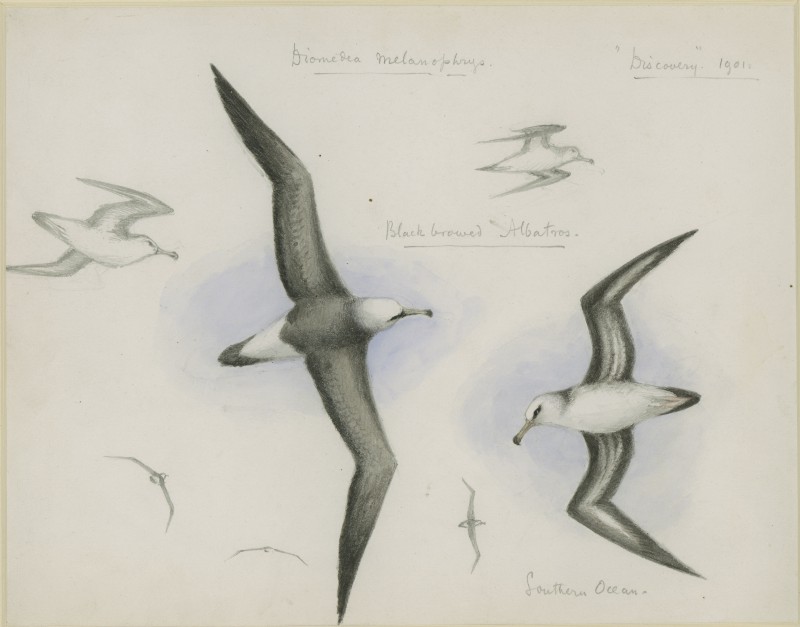
Black-browed Albatrosses in flight in the Southern Ocean, by Edward Adrian Wilson, pencil and watercolour, aboard the Discovery, 1901
Jonathan Rutter (Department of Biology, University of Oxford, UK) and colleagues have published open access in the Journal of Applied Ecology on tracking Black-browed Albatrosses Thalassarche melanophris at sea in relation to the presence of fishing vessels in the South Atlantic.
The paper’s abstract follows:
- “Many pelagic seabird species are threatened by bycatch in fisheries. Bycatch risk assessments benefit from quantifying the frequency, duration and location of individual seabird interactions with fishing vessels. However, proximity-based interaction analyses are limited by the availability and spatiotemporal resolution of bird and vessel tracking data.
- Here, we examined whether patterns in seabird landing and take-off behaviour (immersion) derived from GLS-immersion loggers (0.167 Hz) can detect vessel interactions when tracking data are lacking or incomplete. We identified close-proximity seabird-vessel interactions by spatiotemporally matching high-resolution GPS data (0.02–1 Hz) from 45 black-browed albatrosses (Thalassarche melanophris) to Automatic Identification System (AIS) data from trawler vessels. We used random forest models to investigate whether immersion patterns alone could distinguish these vessel interactions from natural foraging behaviours.
- We observed multiple seabird-vessel interaction types, with active vessel ‘following’ (with multiple landings) comprising only 59% of discrete interaction events. Other interaction types included ‘stopping’ (with 1 landing) and ‘passing’ (with 0 landings).
- Using immersion patterns alone, we could distinguish vessel following in >80% of both foraging timesteps and discrete foraging bouts, with false positive vessel following detections totalling <10% of true positives.
- We found that GLS-immersion loggers sometimes remain wet following take-off, leading to inflated durations of on-water periods. However, leaving this error uncorrected only slightly reduced the performance of our random forest models.
- Policy implications. We demonstrate that seabird immersion patterns alone can detect high-risk seabird-vessel interactions, even in the absence of locational data for both seabirds and vessels. Our approach could allow for more comprehensive seabird bycatch risk assessments that quantify previously hidden seabird-vessel interactions, such as those involving migratory life history stages and illegal, unreported or unregulated (IUU) fishing vessels.”
Read a popular account of the publication.
Reference:
Rutter, J.D., Carneiro, A.P.B., Catry, P., Maurice, L., Padget, O., Davis, K.J. & Guilford, T. 2025. Immersion patterns alone can predict vessel following by albatrosses. Journal of Applied Ecology 62: 1831-1843.
John Cooper, Emeritus Information Officer, Agreement on the Conservation of Albatrosses and Petrels, 11 August 2026

 English
English  Français
Français  Español
Español